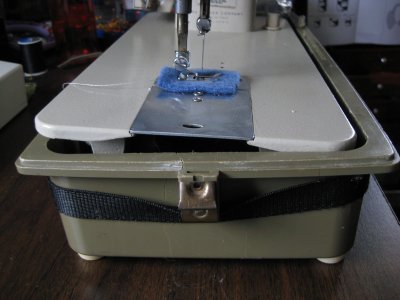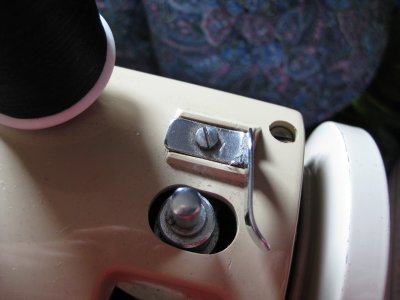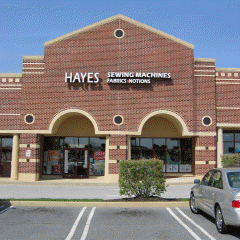When I sent off my lamented Pfaff to be fixed, I hauled out the Singer Fashion Mate 237 I bought several years ago as a stand-in. I’d gotten it in California, after I’d ended up living there unexpectedly for months, far from home, and without access to sanity-preserving activities. It fit the bill well — the Fashion Mate’s a solid work horse.
When I returned from California, I hand-carried the machine onto the plane; once I was home, I put it into storage without opening it. This week, I was surprised (and horrified) to discover that several things had happened during transit. First of all, the lower part of the case had cracked and split on one end. That’s a big deal for this machine. It’s designed so that it can be used in the case, or lifted out and used in a custom table. Nicely versatile! However, I don’t have the requisite table, so I must use the case as a base.
The problem, of course, is that this machine is a tank, and it weighs like one. If you want to tip the machine back to view the underside, you first must slip support strips out from the underside of the case — otherwise, machine and case fall over backwards together. You can imagine the problem, then, once the case has cracked, since it’s barely strong enough to support the machine in the first place.
The immediate fix for the case was this belt:
It’s just a strip of webbing wrapped as tightly as possible around the case. Surprisingly, it works pretty well. Well enough, anyway. The weight of the machine still pushes the case out a little, so that the machine’s at an exaggerated angle, but I can work with that.
More problematic were two other difficulties: When the case shifted, it somehow flattened the bobbin winder stop, and the spring that belongs on the bobbin winder went AWOL. (That wasn’t too surprising; sometime long ago it had been repaired with a somewhat clumsy weld.)
I bent the bobbin winder stop back up, but you can see that the metal along the fold is cracked, and about to break:
That post rising out of the machine is the bobbin winder assembly; the curved arm behind it is the bobbin winder stop. It’s held in place with the bobbin winder stop screw, and beneath that is the bobbin winder stop screw nut. (You never know when the right words might come in handy . . . )
And here’s the bobbin winder tension bracket and thread guide, with the lump of welding where the spring used to be. You can see that it has issues in a previous life, because the machine is scratched and grubby under where the spring should be:
There was just enough of a groove in the weld on the bracket to allow thread to feed through as I sewed this week, but this arrangement wouldn’t have worked if I’d been sewing on a more finicky fabric — or with a more finicky thread. The bobbin stop was less of an issue, since it’s possible to stop the bobbin manually. I managed to make a pair of Marcy Tilton’s pants using the machine as is, but it was a kludgy arrangement. The next garment, though, is definitely made from more sensitive material, so a fix was critical.
An Internet search turned up a fantastic parts list at TNT Repair. It was for slightly newer machines than my 237, but the schematic was pretty much the same, and it gave me the vocabulary I needed to describe the parts. I couldn’t order the spring from them, though, not only because I needed it immediately, but because my machine doesn’t seem to be in their inventory. Their extensive lists — culled, it seems, from old Singer service manuals — did make parts identification easy, and I will be keeping them in mind for accessories or parts I might need in the future, if I can’t find them locally.
Once I knew what to call the missing part, I called up Trev Hayes of Hayes Sewing Machines in Wilmington, Delaware. Wilmington’s far enough from my home that I don’t get there too often, but when I do, I always stop in at Hayes. They carry a full line of Kwik Sew, Lazy Girl Designs and a few other independent patterns, tons of machine accessories and embroidery and purse-making notions and an especially good selection of cottons. They’re also very helpful and friendly; it’s a family-owned store, and it shows.
Best of all, though, is that Trev Hayes repairs machines in his shop. I removed both parts from the machine, wrote a list of the parts involved (so that I’d know what I was talking about), and printed photos of the damage, since I really didn’t want to haul the machine around. (The case would never have survived.) Thus armed, I took off for Wilmington.
Trev Hayes took a look at the parts and announced that he’d get the “boneyard”. I knew exactly what he meant — my parts numbers were probably useless, since it wasn’t very likely anyone had an inventory anywhere. But there was a box of parts cannibalized from decommissioned machines in the back of the shop, and that’s where my hopes rested.
Mr. Hayes pulled a chair up to a table, handed me the box, and I plunged right in. Much to my happiness, I found the critical piece — the bobbin winder tension bracket and thread guide — almost immediately. No gold rush miner could have been more pleased — and I think Trev Hayes was just as tickled as I was!
I didn’t find the bobbin stop, but that I can live without. I did some shopping while I was at the store (and even found some super-light sew-in interfacing I’d been searching for fruitlessly elsewhere), and then headed home. Replacing the parts wasn’t difficult; it just took care, patience, and careful use of a pair of tweezers — the inverse of the procedure I’d used to remove them.
So now my back-up machine is back in business. Here’s how that spring is supposed to look:
I always spend too much when I go to Hayes, but experiences like these are a vivid reminder of how much more an independent store, owned and run by someone who really loves and understands his work, offers those of us who feel the same about what we do. There’s no Trev Hayes at a place like JoAnn’s — in fact, there’s hardly even anyone who sews. It’s important to do what we can to keep these independent stores alive — a world full of nothing but JoAnn’s would be a grim place indeed.





